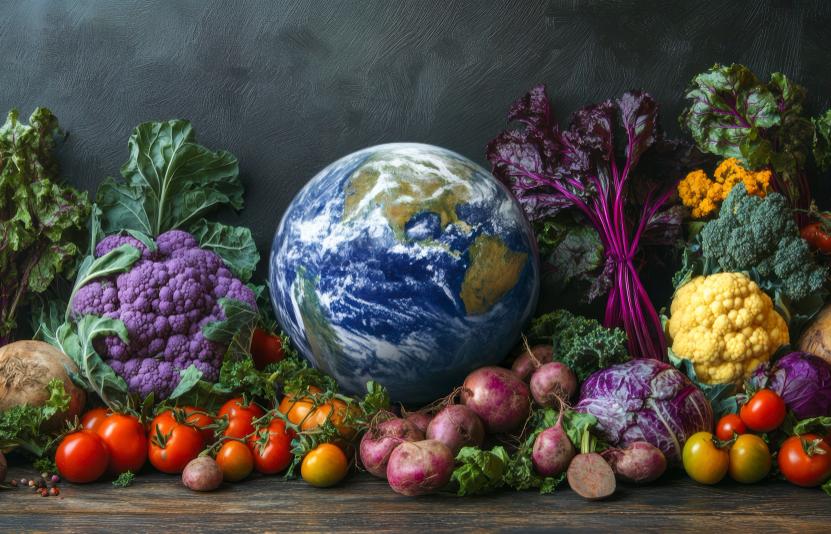Ever wondered why you feel like a balloon after that virtuous salad? You’re not alone.
Picture this: You’ve swapped your afternoon chips for a handful of almonds, traded white bread for whole grain everything, and loaded up on all those green vegetables your mom always told you to eat. You’re basically the poster child for healthy eating, right? So why does your stomach feel like it’s staging a revolt every evening?
Here’s the plot twist nobody talks about – some of the most celebrated “health foods” might actually be the culprits behind your digestive drama. I know, I know. It sounds like nutritional blasphemy, but hear me out.
The Great Digestive Deception
We’ve been conditioned to believe that if a food is labeled “healthy,” it automatically agrees with our bodies. But here’s what I’ve learned after years of wondering why my stomach had more mood swings than a teenager: our digestive systems are gloriously unique, and sometimes the foods we think are doing us favors are actually throwing tiny tantrums in our gut.
The truth is, digestive comfort isn’t one-size-fits-all. What makes your best friend feel energized might leave you feeling like you’ve swallowed a basketball. And surprisingly, many of these troublemakers are hiding in plain sight on the “superfood” shelves.
The Sneaky Seven: When Good Foods Go Bad (For Your Belly)
1. Cruciferous Vegetables: The Overachievers
Broccoli, cauliflower, Brussels sprouts, and cabbage – they’re basically the valedictorians of the vegetable world. Packed with vitamins, minerals, and cancer-fighting compounds, these vegetables deserve their healthy reputation. But here’s where things get complicated.
These veggie superstars contain complex sugars called raffinose that our bodies struggle to break down completely. When these sugars reach our colon undigested, the bacteria there have a field day fermenting them, producing gas as a byproduct. It’s like hosting an uninvited party in your intestines.
The sulfur compounds in cruciferous vegetables can also contribute to that distinctive… aroma… that sometimes follows their consumption. If you’ve ever wondered why your stomach feels like it’s auditioning for a percussion section after a healthy stir-fry, now you know.
The workaround: Start small and build tolerance gradually. Cooking these vegetables thoroughly can also help break down some of those tough fibers, making them easier to digest.
2. High-Fiber Foods: Too Much of a Good Thing
Fiber is the golden child of nutrition advice. “Eat more fiber!” they say. “It’s good for everything!” they promise. And they’re not wrong – fiber is incredibly beneficial for long-term digestive health, heart health, and blood sugar management. But here’s the catch: your digestive system needs time to adjust to increased fiber intake.
Jumping from a low-fiber diet to suddenly munching on bran cereal, whole grain bread, and fiber-packed fruits can shock your system. Your gut bacteria, which help break down fiber, need time to multiply and adapt to their new workload. In the meantime, all that extra fiber can ferment in your colon, leading to gas, bloating, and discomfort.
It’s like asking someone who barely walks to suddenly run a marathon – even good things need gradual introduction.
The smart approach: Increase fiber slowly, adding just a few grams per week, and drink plenty of water to help it move through your system smoothly.
3. Raw Vegetables: The Crunchy Culprits
Instagram loves a good raw veggie bowl, and there’s no denying that raw vegetables preserve more of their vitamin content. But here’s what your feed won’t tell you: raw vegetables are significantly harder to digest than their cooked counterparts.
Those satisfying crunch sounds? That’s your teeth doing work that your digestive system will have to finish later. Raw vegetables contain tough cellular walls that require more energy and stomach acid to break down. For some people, especially those with sensitive stomachs or certain digestive conditions, this extra work can translate to bloating, gas, and general discomfort.
Vegetables like raw carrots, bell peppers, and leafy greens can sit in your stomach longer than you’d expect, potentially causing that heavy, uncomfortable feeling hours after eating.
The gentle solution: Lightly steaming or sautéing vegetables breaks down those tough fibers while still preserving most of their nutritional value.
4. Beans and Legumes: The Protein Powerhouses with a Gassy Reputation
Beans, lentils, chickpeas, and other legumes are nutritional rockstars – they’re loaded with protein, fiber, and essential minerals. They’re also budget-friendly and environmentally sustainable. But let’s address the elephant in the room: the gas.
Legumes contain oligosaccharides, complex sugars that humans don’t have the enzymes to digest properly. These sugars travel to the colon largely intact, where bacteria ferment them, producing gas as a natural byproduct. It’s not a bug in the system – it’s a feature, albeit an uncomfortable one.
The higher the fiber content, the more potential for digestive drama. And if you’re not a regular bean eater, introducing them suddenly can be particularly challenging for your system.
The gradual game plan: Start with smaller portions and canned varieties, which are often easier to digest than dried beans. Rinse canned beans thoroughly to remove some of the gas-producing compounds.
5. High-FODMAP Fruits: Nature’s Sweet Saboteurs
Fruits are nature’s candy, packed with vitamins, antioxidants, and natural sweetness. But some fruits contain high levels of FODMAPs (fermentable oligosaccharides, disaccharides, monosaccharides, and polyols) – types of carbohydrates that can cause digestive distress in sensitive individuals.
Apples, pears, watermelon, and stone fruits like peaches and plums are particularly high in these compounds. The fructose in these fruits, when consumed in large amounts or by sensitive individuals, can be difficult to absorb completely. Unabsorbed fructose reaches the colon and provides fuel for bacteria, leading to gas and bloating.
Even dried fruits can be problematic – they’re concentrated sources of these sugars, plus many commercial varieties contain added sorbitol, a sugar alcohol that can have a laxative effect.
The balanced approach: Enjoy these fruits in smaller portions, and pair them with other foods to slow absorption. Berries, citrus fruits, and bananas are generally better tolerated.
6. Nuts and Seeds: The Concentrated Troublemakers
Nuts and seeds are nutritional powerhouses – they’re rich in healthy fats, protein, and minerals. They’re also incredibly convenient and satisfying. But their concentrated nature can sometimes work against sensitive digestive systems.
The high fat content, while healthy, can slow down digestion for some people. Fats take more time and energy to break down, potentially leading to that heavy, sluggish feeling. Additionally, the fiber and protein density means a small handful packs a digestive punch that your system might not be expecting.
Certain nuts, like cashews and pistachios, are also higher in FODMAPs, which can trigger symptoms in sensitive individuals. And let’s be honest – it’s easy to overdo it with nuts, turning a healthy snack into a digestive challenge.
The mindful method: Stick to appropriate portions (about a small handful), and consider soaking raw nuts to make them easier to digest.
7. Whole Grains: The Complex Carb Confusion
Whole grains are consistently recommended as a healthier alternative to refined grains, and nutritionally, they absolutely are. They contain more fiber, protein, and micronutrients than their processed counterparts. But this extra nutritional density can sometimes be a double-edged sword for digestion.
The bran layer in whole grains, while nutritious, contains compounds called phytates that can be difficult for some people to digest. Additionally, certain grains like wheat, rye, and barley contain gluten and other proteins that can cause digestive distress even in people without celiac disease.
The sudden switch from refined to whole grains can also shock a system that’s used to easily digestible carbohydrates. Your digestive enzymes and gut bacteria need time to adapt to processing these more complex foods.
The transitional tip: Make the switch gradually, mixing whole grains with familiar refined options initially, and pay attention to how different grains affect you individually.
Reading Your Body’s Signals
Here’s what I wish someone had told me earlier: your body is constantly giving you feedback about what works and what doesn’t. That afternoon bloating isn’t just bad luck – it’s information. Those middle-of-the-night stomach rumblings aren’t random – they’re your digestive system trying to communicate.
The key is learning to listen without judgment. Just because a food is healthy doesn’t mean it’s healthy for you, right now, in the amount you’re eating it. And that’s okay. Your digestive needs might change with stress, age, activity level, or even the seasons.
Working with Your Unique System
Instead of forcing yourself to eat foods that consistently make you uncomfortable (even if they’re “supposed” to be good for you), consider these approaches:
Keep a simple food and symptom journal for a week or two. You don’t need to weigh and measure everything, but noting what you eat and how you feel afterward can reveal patterns you might have missed.
Experiment with preparation methods. Sometimes it’s not the food itself but how it’s prepared that makes the difference. Raw might not work for you, but cooked might be perfect.
Practice portion awareness. Even foods that agree with you in small amounts might cause issues in larger portions. Your digestive capacity isn’t infinite.
Consider timing. Some foods might work better at certain times of day or when combined with other foods that aid digestion.
Be patient with changes. If you want to include more of these nutritious foods in your diet, introduce them slowly and give your digestive system time to adapt.
The Bottom Line: Health is Personal
The most important lesson I’ve learned about digestive health is that it’s deeply personal. Your body’s responses are valid, even if they don’t match what you read online or what works for your friends. A truly healthy diet is one that nourishes you without causing consistent discomfort.
This doesn’t mean giving up on nutritious foods entirely. Instead, it means finding your own path to including them in a way that works for your unique system. Maybe that means smaller portions, different preparation methods, or simply choosing alternative foods that provide similar nutrients without the digestive drama.
Remember, the goal isn’t to eat perfectly according to someone else’s definition of healthy. The goal is to fuel your body with foods that make you feel energized, satisfied, and comfortable. Sometimes that means embracing the fact that your version of healthy eating might look a little different from what you see on social media – and that’s perfectly okay.
Your digestive system is working hard for you every single day. The least we can do is listen to what it’s trying to tell us and work with it, not against it.

Important Disclaimer: This article is for informational and educational purposes only and is not intended as medical advice. The information provided should not be used for diagnosing or treating any health condition. Individual responses to foods can vary significantly based on many factors including underlying health conditions, medications, and personal sensitivities. If you experience persistent digestive symptoms, significant discomfort, or have concerns about your digestive health, please consult with a qualified healthcare provider or registered dietitian who can provide personalized guidance based on your individual needs and medical history.
Sources: This article draws upon research and information from various nutrition and digestive health resources, including guidelines from the International Foundation for Gastrointestinal Disorders (IFFGD), Cleveland Clinic, Mayo Clinic, and peer-reviewed nutritional research on FODMAPs and digestive health published in medical journals.



